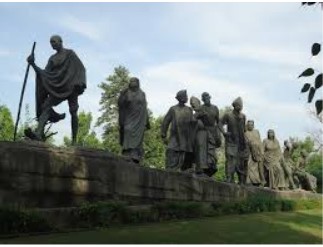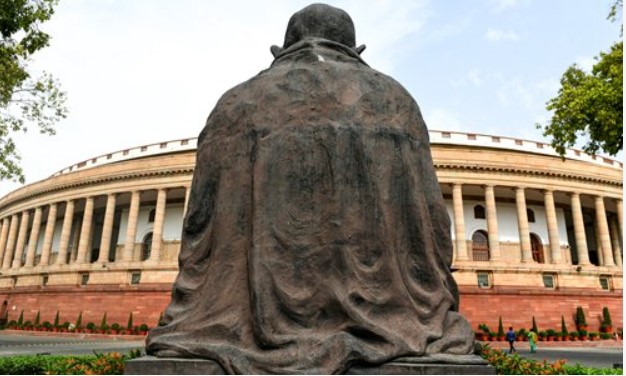
We claim that spaces speak volumes about how man wields power. The origin story of immobile life-size figures that loom over human settlements are centuries old. The stories of these statues that are left to bear witness to the joys and horrors of earth, determine the space they claim on our streets. They are a measure of the imagination, values, and fears of a community. Statues do not just keep an eye on society, they tell us stories of a time, its people, their beliefs, and principles. Statues serve multiple purposes, some are reminiscence of the virtues and contributions of personalities, erected either in their lifetime or later, either by them or by others. Hence, the politics of who erects statues and for whom is also a story in itself. On the other hand, life-size God figures function to imprint fear and faith in people.
The statues of Delhi then, in particular, have a heavy responsibility. New Delhi being the national capital is expected to be the epitome of leadership and idealism. So the expectation on the statues that adorn the city is big.
Delhi as a city has been a host to a myriad of political and aesthetic principles which are also visible in the statues around the city.
The politics of the neglected and untended statues of Coronation Park, where King George V stand-alone overlooking the other empty statue stands, with no inscriptions on its plinths, is a strong one. The very act of removing all statues that were representative of the imperial rule from their founding locations, to a historically important site as the coronation ground, was an act to reclaim the city as Indian while recovering the history that shaped India of today.

In contrast, Devi Prasad Roy Chowdhury’s Gyarah murti or 11 murtis shows Gandhi and ten other people in a representation of the vast multitude of people who joined Gandhi in this historic march. The party is moving forward and urging one another to continue. The figures aren’t people of eminence; they represent the commoner and their rigor in winning back freedom for their nation. The visionary artist has included minute details to the statues that suggest the different socio-religious backgrounds of the followers, all united by one cause, Independence. We can see Women, Hindu Pandits, Muslims, Christian priests, Farmers, the old and young among the figures. The image of this statue used to claim its position on the backside of the 500 rupee note before it got banned in 2018. This sculptor is a powerful statement in the past, present, and future of India and is a call for unity, fraternity, and tolerance in all endeavors as a nation.
Close to the Gyarah Murty, the 16 feet statue of Gandhi at the Parliament holds great significance. Over the years, it has seen multiple protests by parliamentarians and holds witness to the politics of the representative’s house. This statue in particular acts as a constant reminder for the nation’s power-wielders to stay true to the founding principles of the constitution. This is another sculptor of Gandhi’s sculpted by Ram Sutar, which was presented to the nation in 1993 on Gandhi’s birth anniversary.
The bronze figure of King Edward VII, which used to adorn the park was reinstalled to Coronation park, in the 1960s when the Delhi government was actively shifting all symbols of colonial power and cleansing the city. This incident reinforces the ideological relationship between statues and the projection of power and culture. This park now houses the statue of Netaji Subhash Chandra Bose and his INA soldiers. The park was initially named after King Edward VII and later after this legendary freedom fighter. This very act of renaming the park is an act of recovery, an effort at reclaiming the spaces that belong to Indians.
The presence of statues of Russian personalities is a reminder of New Delhi’s strong erstwhile relations with Moscow. In fact, some of these statues rarely exist anywhere else in the world but stand proud in the spaces of Delhi as a reminder of how Nehru’s socialist roots shaped India’s early development.

The Statue of Leo Tolstoy is a symbol of Russian influence in Indian literature and politics. The wide circulation of the multitude of Tolstoy’s novels is testimony to the influence of this literary genius in the literary fervor of India. But one can’t stop noticing how the state bank of India flex board dilutes the aesthetics of this statue. This statue of Tolstoy with his arms crossed overlooking the Janpath market holds not much explanation to the local eye on the greatness of the man on it because the plinth merely says his name and year of establishment of the statue. Tolstoy’s influence over Gandhi in developing ideas of non-violence, chastity, and sexual abstinence is another reason for us to look up at this statue fondly.
Apart from Delhi, only two other places in India have Lenin statues, Kolkata and Vijayawada. This Lenin Statue at Nehru park was inaugurated by Nikolai Ryzhkov, the then USSR Premier, on November 1, 1987, as part of the 70th anniversary of the Russian Revolution. Lenin Statue could also be read as a diplomatic statement of the relations India has with other nations.
But the fact that the park is named after Nehru and has no statues of him instead has one of Lenin’s is confusing enough for the local eye.
P.B.Shelley in his poem Ozymandias questions the idea behind lifeless statues, the purpose, and the politics behind them because nothing is immune to the wrath of time except words; literary expressions of the ideals people or things symbolize. The amount of time, money, and space that goes into the construction of statues that race to kiss the sky are topics of heated debate in our country. In that context, the stories that the statues of Delhi tell, and are made to tell are a reflection of the differences in opinion, outlook, and narratives. The fact that when Nehru’s statue at JNU is made to hold banners for protesters (symbolizing how his ideals are reflected in their outcry), Vivekananda’s statue was covered in Saffron clothes and vandalized, speaks volumes about how the people and governments wield the ideals of individuals (who one way or the other contributed to the political, spiritual awakening of the subcontinent) to their convenience. On the other hand, when the effigies of colonial overloads are uprooted from the heart of the nation’s capital in an attempt to cleanse the city from the influence of the alien culture and practices, the voice of the nation seems to converge. When politicians hold on to the Gandhian statues and protest in the parliament premises, the voices of the powerful factions echo differently. When the Lenin statue in Tripura was vandalized, nation’s historians called for statues of more humanitarian global figures, like Nelson Mandela, Dalai Lama, and Martin Luther King in the national capital. Statues of Delhi are a statement, the nation’s statement on its ideals and beliefs and it is up to the citizens and the government to unbiasedly shape its image.

